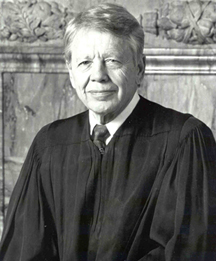James R. Browning
| James Browning | |
|---|---|
 |
|
| Chief Judge of the Court of Appeals for the Ninth Circuit | |
|
In office June 30, 1976 – June 15, 1988 |
|
| Preceded by | Richard Chambers |
| Succeeded by | Alfred Goodwin |
| Judge of the Court of Appeals for the Ninth Circuit | |
|
In office September 18, 1961 – September 1, 2000 |
|
| Nominated by | John F. Kennedy |
| Preceded by | Walter Pope |
| Succeeded by | Sandra Ikuta |
| Personal details | |
| Born | October 1, 1918 Great Falls, Montana, U.S. |
| Died | May 6, 2012 (aged 93) Marin County, California, U.S. |
| Alma mater | Montana State University, Bozeman |
James Robert Browning (October 1, 1918 – May 6, 2012) was an American judge of the United States Court of Appeals for the Ninth Circuit. He served 50 years on the court—the longest tenure of any U.S. Circuit Judge—and authored more than 1,000 published appellate decisions. While Chief Judge of the Ninth Circuit, he oversaw numerous reforms that modernized and increased the efficiency of the circuit's administration.
Browning was raised in Belt, Montana, where he attended public school. He was nicknamed "Tiny" as a child, only growing to an adult height of 5 ft 2 in (1.57 m). Browning received his undergraduate degree from Montana State University in 1938, and an LL.B. from Montana University Law School in 1941, where he graduated at the top of his class and served as editor-in-chief of the law review. After law school, he joined the Antitrust Division of the United States Department of Justice in Denver, Colorado. In 1943, he entered the United States Army as a private during World War II. He spent three years in the Pacific Theatre in military intelligence, and earned a Bronze Star and the rank of first lieutenant.
Browning left the army in 1946 and returned to the Department of Justice, where he proceeded to rise through the ranks over the following seven years. He served in the Washington, D.C. Antitrust Division office until 1948, when he moved to the Seattle office to serve as northwest regional chief. Browning came back to D.C. the following year to serve as assistant chief of the Antitrust Division's General Litigation Section, first assistant in the Civil Division from 1951–1952, and executive assistant to the U.S. Attorney General. In 1953, he organized and served as the first chief of the Executive Office for U.S. Attorneys (EOUSA).
...
Wikipedia
